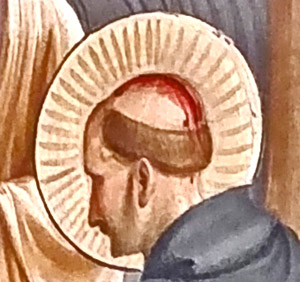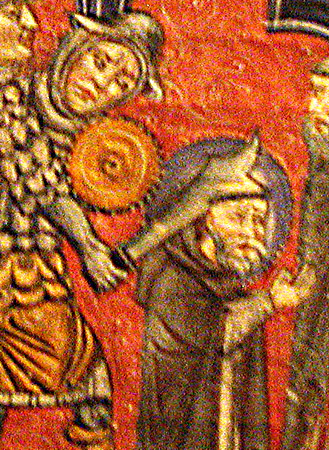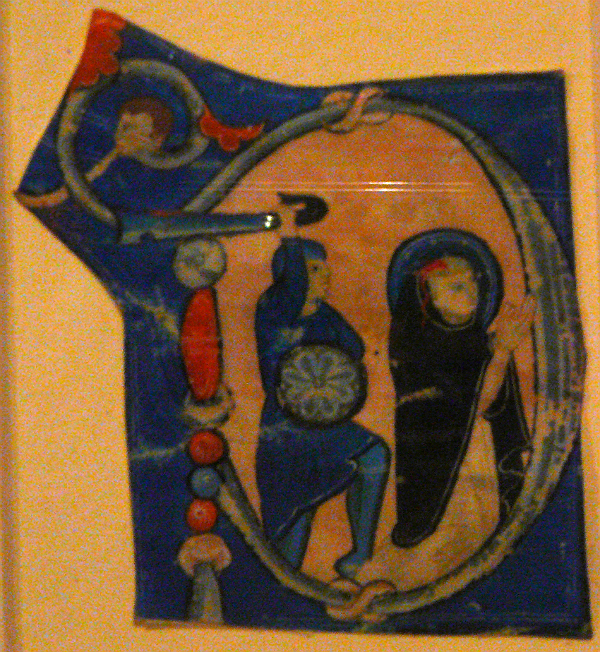The ultimate source of the "falchion" detail is not the Legend but the inquest that followed Peter's death. It said the gash was caused by "the force of the impact of a falchion, whose blade ends in two horns, like the moon."1 We see just such a weapon in the second picture at right.
The description in the inquest led some artists to picture something more like a bill-hook, as in the third picture, and by the time statues of the saint got to Mexico it had become more like a broad-axe, as in the fourth. It is rare for him to be pictured without either a weapon or a gash in his head (exception).
The "heretics" in question were Cathars, a sect that was then gaining strength in northern Italy and against whom Peter had been preaching. The Legend and the decree of canonization speak as if only one of the Cathars did the deed, but the inquest names two.2 It also speaks of a second blow to the saint, a dagger thrust into his shoulder, and of a second victim, a friar named Dominic. The second blow and the second friar are included in this painting. Some images picture the assailants as soldiers; others make them desperadoes in tattered clothing.
Many narrative images portray miracles performed through the saint's prayers during and after his lifetime (example - the severed foot). Two narrative cycles are in the chapel in Milan that houses Peter's remains. One is a set of frescos Vincenzo Foppa painted in 1468 in which we see the saint restoring a severed foot, exposing a fake apparition, making a cloud cover his hearers to keep them cool on a summer's day, and writing Credo ("I believe") in the dirt as falls from the assassin's blow. On the elaborate sarcophagus containing the remains, eight panels of relief sculpture follow his story from the preaching and miracles to his assassination and the development of his cult.
Most images of St. Peter Martyr make him a man in middle age, but in a few he is quite young, and some others give him a gray beard. He is often seen grouped with other Dominicans in the Order's churches (example).
Prepared in 2015 by Richard Stracke, Emeritus Professor of English, Augusta University. Revised 2017-01-16,30, 2020-08-04.

Often Peter is identified by a gash in the head, as in this detail from a Fra Angelico Nativity. (See the description page.)

Detail from a miniature: The saint is killed with the "falchion" described in the inquest (See the description page)

A knight using a bill-hook to kill the saint (See the description page)

In Mexico the sword often becomes a broad-axe like this one in the Church of SS. Peter and Paul, Etla, Mexico. (See the description page.)
ATTRIBUTES
- Axe or sword in his skull, or a wound in the skull as from an axe or sword
- Black and white Dominican habit
MORE IMAGES
- Early 14th century: St. Peter Martyr's portrait is among Aretino's panels of Apostles and saints in Santa Maria Novella, Florence.
- 1366-67: In the bottom register of Bonaiuto's The Church Militant and the Church Triumphant the Dominican saint preaching to a hostile crowd is probably our Peter.
- 15th century: A della Robbia Lunette with the Madonna and other Dominican saints.
- 1440: Pietro di Sano's narrative cycle celebrating miracles of St. Peter Martyr.
- 1440s: Fra Angelico's frescos of St. Peter Martyr adoring the Cross and scourging himself in the friars' cells in the convent of San Marco, Florence.
- 1441-43: Fra Angelico's portrait of St. Peter Martyr "shooshing" the monks hangs over the entrance from the convent to the church of San Marco in Florence.
- 1441-43: The saint appears at the far right in Fra Angelico's The Crucifixion.
DATES
- Feast day: April 29
- Born 1205 in Verona
- Died 1252, entombed in Milan
- Canonized one year later, in 1253
NAMES
- Also known as Peter of Verona, less often as Peter of Milan
BIOGRAPHY
- Golden Legend #63: html or pdf
- Acta Sanctorum, April vol. 3, 678-719. Thomas of Lentino's Vita is on pages 686-719, Innocent IV's decree of canonization on pages 700-702, excerpts from the inquest on pages 680-82.
NOTES
1 Acta Sanctorum, April vol. 3, 681.
2 Acta Sanctorum, April vol. 3, 701 (for the decree of canonization) and 681 (for the inquest).